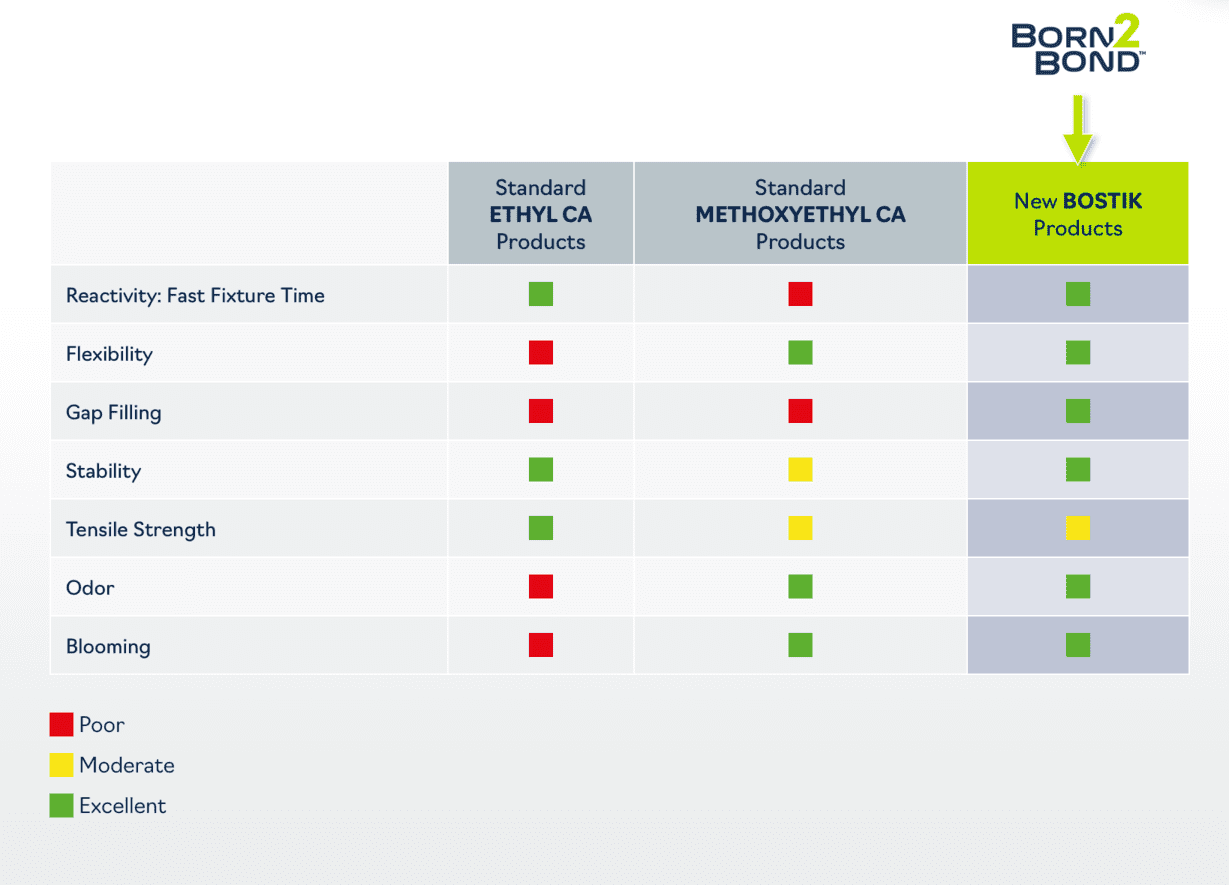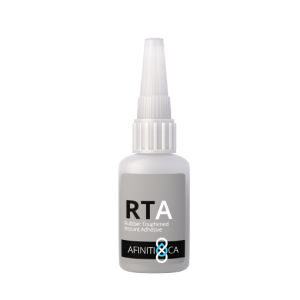Instant adhesive, Cyanoacrylate (CA), Super Glue – What are they?
Instant adhesives, commonly known as Super Glue in households and referred to as cyanoacrylate adhesive in industrial settings, are high-strength, fast-bonding adhesives designed to bond nearly all materials. Highly regarded for their heat and moisture resistance, instant adhesives are typically used with stone, metal, wood, plastic, ceramic, glass, paper, and most common substrates.
While instant adhesives work well with most common materials, avoid using them with cotton, wool, or items that will be placed in microwaves, ovens, or dishwashers. Remember that instant adhesives are often not food-safe.
Instant adhesives commonly come in liquid or gel forms. Liquid is best for penetrating cracks or small gaps and often dries faster than gel. Gel creates a more flexible bond than liquid and has higher viscosity, meaning it drips less, offering better control for applications requiring higher precision or vertical applications, such as model-building or repairing thin, flat objects.
Who invented Super Glue?
Super Glue was invented in 1942 by Dr. Harry Coover. He was part of a wartime research team developing plastics for use in precision gun sights. They stumbled upon a remarkably adhesive chemical compound, but initially found it of little use in their research.
It was only later that Coover recognized the potential of cyanoacrylate as an adhesive and it was commercially produced for sale in 1958. Super Glue quickly became extremely popular as a versatile and useful household adhesive.
Advantages of Instant adhesive, Cyanoacrylate (CA), Super Glue
Quick bonding: The standout feature of Super Glue is its rapid bonding, typically within seconds (10-20 seconds). It cures by moisture, so the warmer and more humid the environment, the faster the bond.
High bonding strength: Compared to other types of adhesives (e.g., silicon, MS polymers), Super Glue boasts extremely high bonding strength. For example, when bonding Nitrile Butadiene Rubber (NBR), shear strength can exceed 8 N/mm2.
Material compatibility: Super Glue is generally quite versatile and will work with most materials. It can bond the majority of common metals, wood, ceramic, glass, some types of rubber, and plastics, among others.
Economical: Super Glues are very economical to use. While instant adhesives may seem somewhat expensive compared to other adhesives, considering the amount of application, Super Glue requires only a small amount for bonding. As a general rule, a drop of Super Glue is enough to cover an area of approximately 25mm2. A common mistake when using Super Glue is using too much, which can slow down the curing process and, in certain cases, even reduce the ultimate bonding strength.
Simplicity – No mixing required: Super Glue is a single-component adhesive, meaning no mixing is required. This helps reduce complexity as some other types of adhesives require precise combination of different components to work.
Limitations of Instant adhesive, Cyanoacrylate (CA), Super Glue
Not suitable for large surfaces: Instant adhesives are typically used for bonding small parts due to their fast drying time, making them unsuitable for large surface areas.
Low surface energy materials: notoriously difficult to bond. Adhesives form bonds by “wetting” the surfaces they adhere to. Materials with low surface energy resist this wetting and therefore resist bonding. Examples of low surface energy materials include PTFE (commonly known as Teflon), polyethylene, and polypropylene. When using instant adhesives with these materials, a primer may be required.
Requires higher accuracy: due to the fast drying time of the adhesive and its ability to bond to almost anything (including skin), users need to be quite precise when applying super glue.
Blooming: White haze, foul odor, staining: these are common drawbacks of typical cyanoacrylate adhesives. With the advancement of technology, Methoxyethyl Cyanoacrylate adhesive can overcome this.
Types of Instant adhesive, Cyanoacrylate (CA), Super Glue
Cyanoacrylate is an acrylic monomer that polymerizes into a plastic-like material when exposed to ambient moisture.
The first version of cyanoacrylate adhesive, commonly known as Super Glue, was made from the original ethyl formula and is highly versatile for bonding all types of materials such as plastics, metals, composites, glass, and many other materials. Super Glue dries and hardens upon contact with the slightest moisture present on substrates, creating a strong polymerization effect that provides excellent adhesion and fast reliability.
Depending on the application, cyanoacrylate adhesives come in various types, from non-drip, rigid rubber, non-staining, non-hazing, odorless, high-temperature resistant, flexible, and suitable for metal bonding purposes.
With chemical advancements, Methoxyethyl Cyanoacrylate or MECA leads in non-staining, non-hazing, and low to no odor, eliminating the long-standing drawbacks of first-generation methyl and ethyl cyanoacrylates.
Guidance on Choosing Instant adhesive, Cyanoacrylate (CA), Super Glue
The applications of instant adhesives are virtually limitless. Instead of listing everything, here are some key technical points you should know before deciding which cyanoacrylate adhesive is suitable:
Ester type
Usually Ethyl, Alkoxy, or Methyl. Among these, Ethyl Ester is the most common type, and adhesives made from this ester are among the most versatile and flexible super glues. Alkoxy ester-based cyanoacrylates typically produce less white haze and have fewer odors during processing. Methyl ester-based adhesives are particularly compatible with metals.
Viscosity
Higher viscosity means thicker liquid. Viscosity is the main difference between different types of instant adhesives, and whether you desire higher or lower viscosity will depend on your application. Generally, higher viscosity results in slower cure times. Therefore, adhesives with higher viscosity may be easier to use on complex or vertical surfaces because they are less likely to run.
Bonding strength
Different instant adhesives will have different bonding strengths with different substrates. Pay attention to the shear strength of cyanoacrylate adhesive with the materials you intend to bond.
Curing time
Different instant adhesives have different curing times. This time will be influenced by the substrate, environmental conditions, and amount of adhesive used. Typically, adhesives with higher viscosity have longer cure times. All cyanoacrylate adhesives cure quickly and will reach full bond strength in less than 10 minutes.
Instant adhesive, Cyanoacrylate (CA), Super Glue Solutions
Hitta would like to introduce a cyanoacrylate adhesive solution that addresses the limitations of conventional cyanoacrylate technology: odorless; non-hazing, non-staining; high performance.


Purchase Instant Adhesives/Cyanoacrylate (CA)/Super Glue
Hitta specializes in providing various types of adhesives & tapes for both industrial and commercial sectors. Contact us for the most efficient solutions with the lowest costs:
- ☎️ Hotline: 0565 33 68 79
- ✉️ Email: hittajsc@hitta.vn


